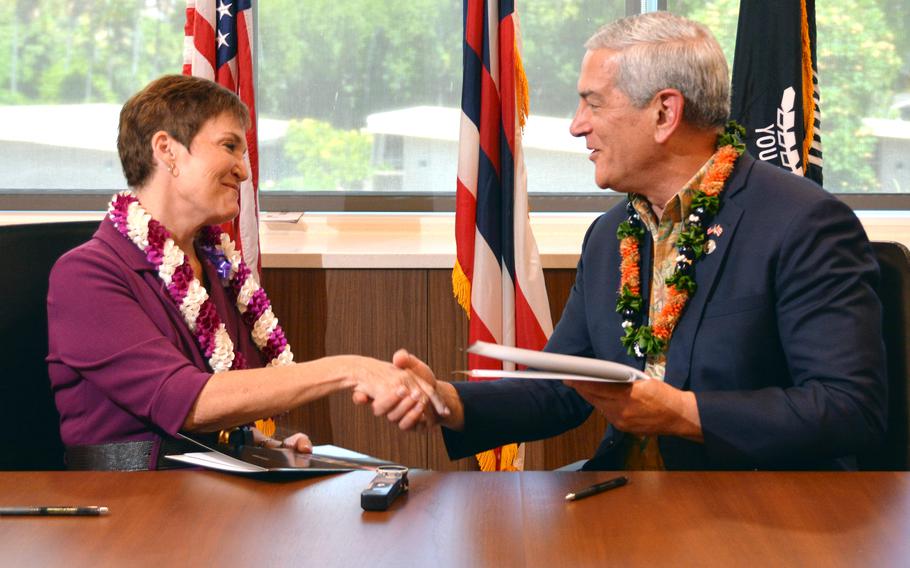
Wendy Hensel, president of the University of Hawaii, and Kelly McKeague, director of the Defense POW/MIA Accounting Agency, shake hands after signing a cooperative agreement on Aug. 19, 2025, at the University of Hawaii-Manoa campus in Honolulu. (Wyatt Olson/Stars and Stripes)
HONOLULU — The University of Hawaii and the Defense Department have entered a five-year cooperation agreement aimed at enhancing efforts to find and identify the nation’s missing war dead.
The deal, signed Tuesday by UH President Wendy Hensel and Defense POW/MIA Accounting Agency Director Kelly McKeague, will also allow students to work alongside scientists at the agency’s state-of-the-art forensic laboratory on Joint Base Pearl Harbor-Hickam.
Under the agreement, students and faculty will gain access to DPAA’s scientific experts, data and lab resources, while the agency will benefit from the university’s academic programs and research facilities.
“Today, we celebrate the beginning of an important new partnership between the University of Hawaii and the DPAA, one that will strengthen science and technology education, expand training and research opportunities and open new career pathways for our students, all while advancing DPAA’s vital mission to account for missing U.S. personnel from prior conflicts,” Hensel said during the signing ceremony on campus.
Roughly 81,000 service members remain missing from World War II and later conflicts. McKeague said just over 37,000 are considered potentially recoverable, with the rest lost at sea or under circumstances that make recovery highly unlikely.
Federal law requires the Pentagon to fund recovery efforts at a level sufficient to account for at least 200 missing personnel each year. After falling short in recent fiscal years, the agency since Oct 1 had made 208 identifications as of Tuesday.
Congress granted the Pentagon authority a decade ago to establish private partnerships in its mission to account for missing service members, and DPAA now maintains 130 such affiliations, McKeague said.
The university and DPAA have been cooperating in an informal manner for years, but the agreement will bring that to a much higher level, he said.
“First of all, it expands — and I believe emboldens — the partnerships that we do have by creating access to the entire university system … to include the School of Medicine, and it just formalizes it, it facilitates it,” he said. “And then, more importantly, in the reverse, we also have an opportunity to open up our facilities, our scientists, to university participants, whether they be faculty or students. Right now, we don’t have that in place. This agreement will allow that to happen.”
Hensel underscored the successful UH-DPAA collaboration that helped to build Cambodia’s archeological workforce and developed a database for isotopic analysis that allows DPAA to distinguish remains of Asian-American service members among those with origins in Hawaii, the U.S. mainland or elsewhere in Asia.
“There are currently two Cambodian students — Cambodian nationals — that are here getting their degree in anthropology that will one day go back to help us with the missing in Cambodia, but also help Cambodia expand its anthropological capacity in-country,” McKeague said. “So, the ramifications for both DPAA and UH extend well beyond the state.”
Hensel also alluded to the importance of continued emphasis on such partnerships at a time when university research is at risk because of deep funding cuts being made by the Trump administration.